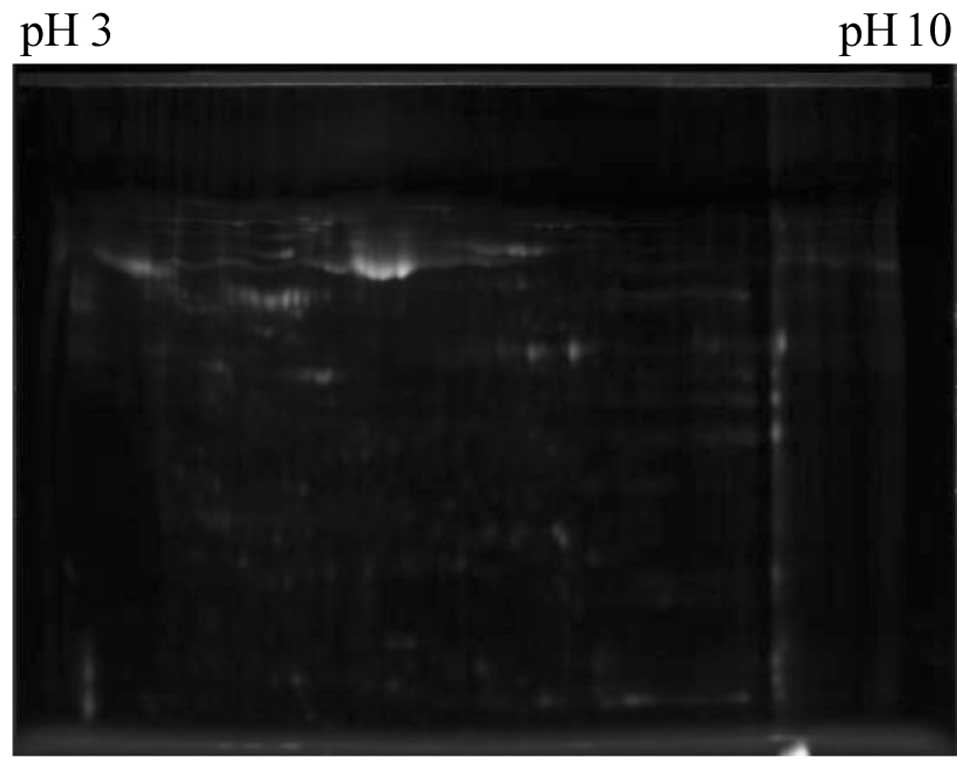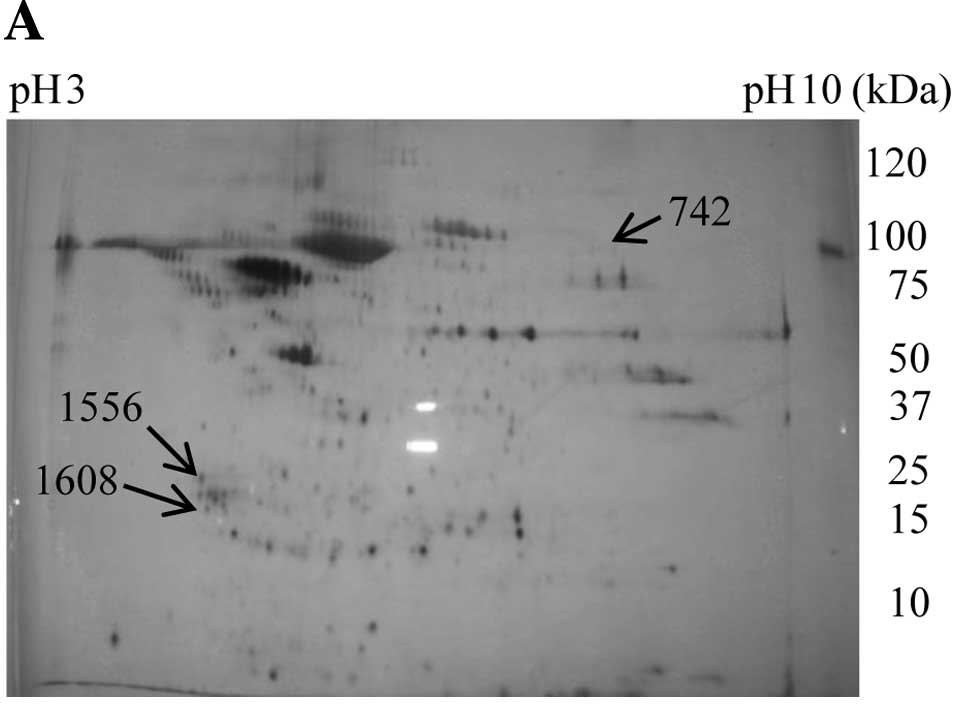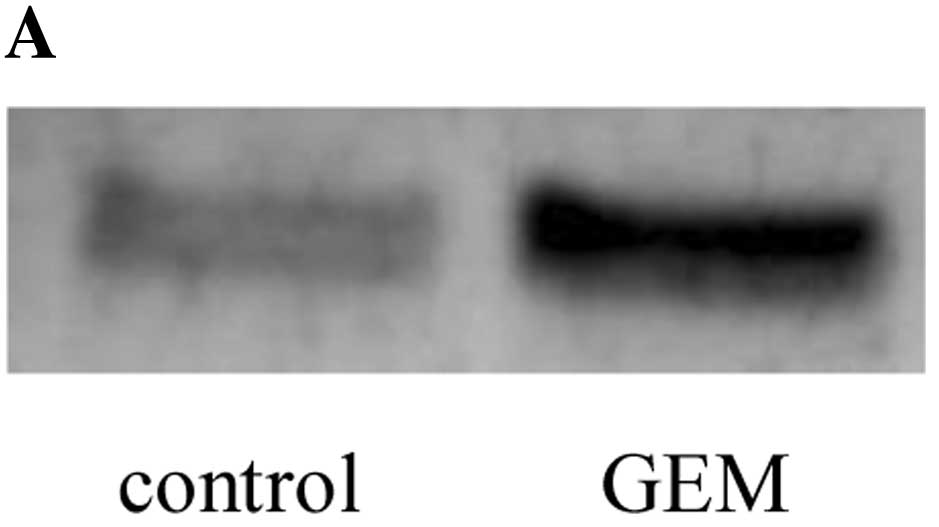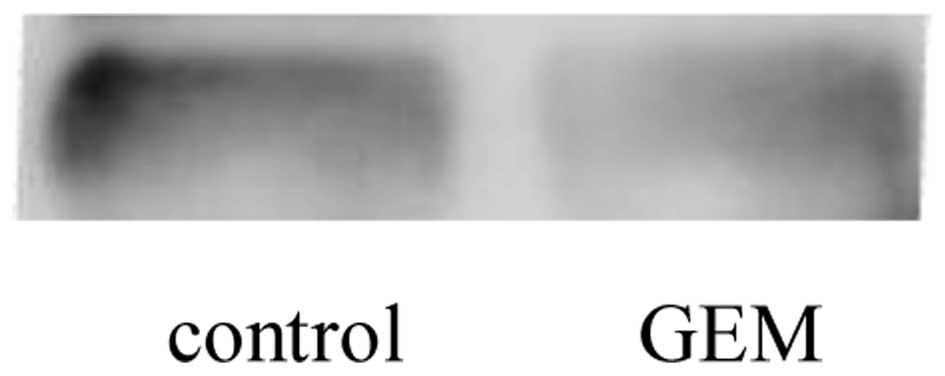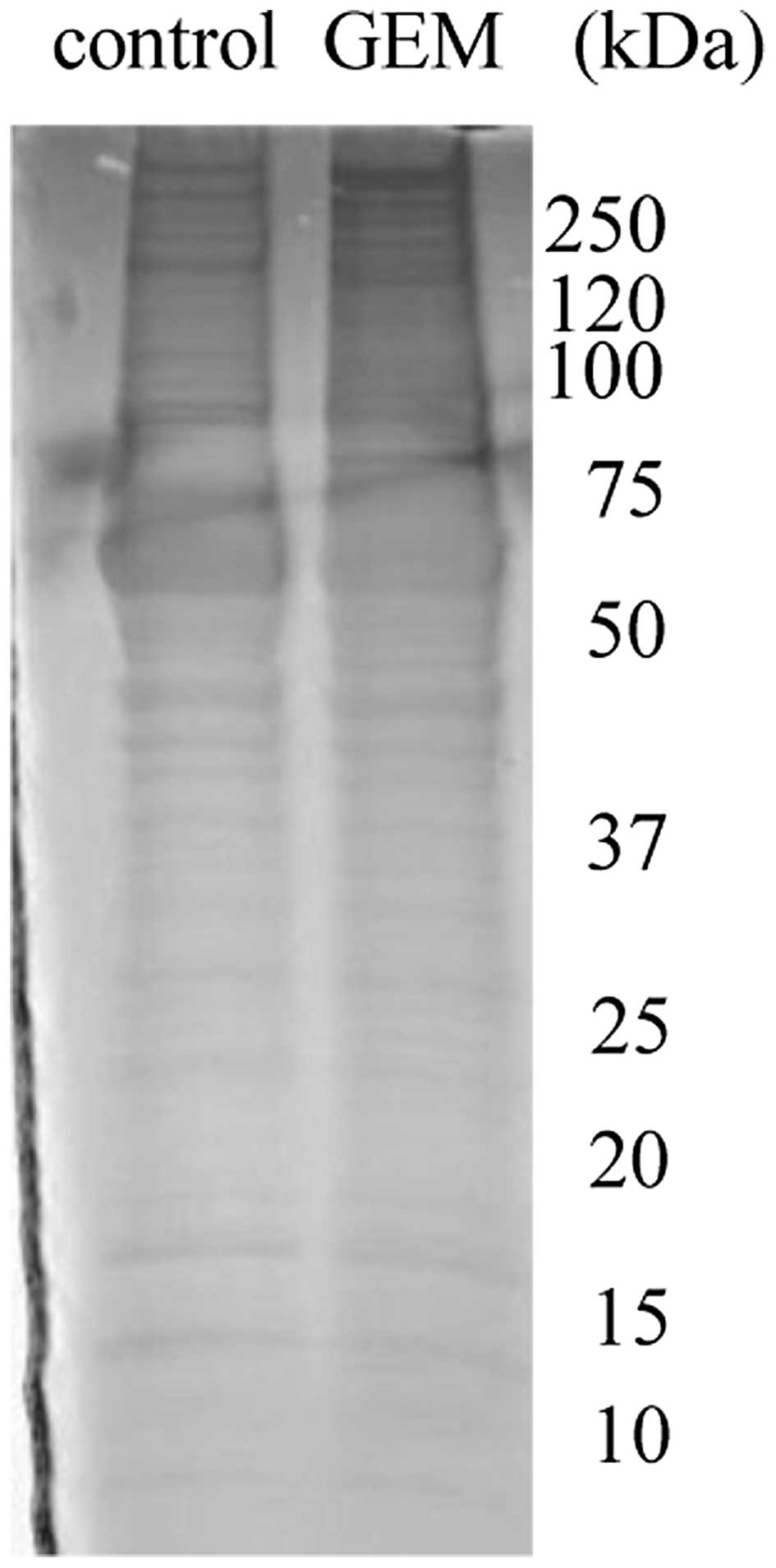|
1
|
Haugk B: Pancreatic intraepithelial
neoplasia - can we detect early pancreatic cancer? Histopahology.
57:503–514. 2010. View Article : Google Scholar : PubMed/NCBI
|
|
2
|
Tanaka M, Javel M, Dong X, Eng C,
Abbruzzese JL and Li D: Gemcitabine metabolic and transporter gene
polymorphisms are associated with drug toxicity and efficacy in
patients with locally advanced pancreatic cancer. Cancer.
116:5325–5335. 2010. View Article : Google Scholar : PubMed/NCBI
|
|
3
|
Shimasaki T, Ishigaki Y, Minamoto T and
Motoo R: The influence of expression of Apopthosis related genes in
pancreatic cell lines treated with gemcitabine hydrochrolide.
Suizo. 22:14–20. 2007. View Article : Google Scholar
|
|
4
|
Wallentine JC, Kim KK, Seiler CE III,
Vaughn CP, Crockett DK, Tripp SR, Elenitoba-Johnson KS and Lim MS:
Comprehensive identification of proteins in Hodgkin
lymphoma-derived Reed-Sternberg cells by LC-MS/MS. Lab Invest.
87:1113–1124. 2007. View Article : Google Scholar : PubMed/NCBI
|
|
5
|
Xue H, Lu B and Lai M: The cancer
secretome: a reservoir of biomarkers. J Trans Med. 6:1–12.
2008.PubMed/NCBI
|
|
6
|
Soares JCS, Santos MF, Trrugilho MRO,
Neves-Ferreira AGG, Perales J and Domont GB: Differential
proteomics of the plasma of individuals with sepsis caused by
Acinetobacter bumannii. J Proteomics. 73:267–278. 2009.
View Article : Google Scholar : PubMed/NCBI
|
|
7
|
Mares J, Thongboonkerd V, Tuma Z, Moravec
J, Karvunidis T and Matejovic M: Proteomic analysis of proteins
bound to adsorption units of extracorporeal liver support system
under clinical conditions. J Proteome Res. 8:1756–1764. 2008.
View Article : Google Scholar
|
|
8
|
Sun Q, Sha H, Yang X, Bao G, Lu J and Xie
Y: Comparative proteomic analysis of paclitaxel sensitive A549 lung
adenocarcinoma cell line and its resistant counterpart A549-Taxol.
J Cancer Res Clin Oncol. 137:521–532. 2010. View Article : Google Scholar : PubMed/NCBI
|
|
9
|
Shi J, Zen Y and Zheng R: Proteome
profiling of early seed development in Cunninghamia lanceolata
(Lamb.) Hook. J Exp Bot. 61:2367–2381. 2010. View Article : Google Scholar : PubMed/NCBI
|
|
10
|
Oshita F, Morita A, Ito H, Kameda Y,
Tsuchiya E, Shigeru A and Miyagi Y: Proteomic screening of
completely resected tumors in relation to survival in patients with
stage I non-small cell lung cancer. Oncol Rep. 24:637–645. 2010.
View Article : Google Scholar : PubMed/NCBI
|
|
11
|
Varo I, Rigos G, Navarro JC, del Ramo J,
Giner C, Hernandez A, Pertusa J and Torreblanca A: Effect of
ivermectin on the liver of gilthead sea bream Sparus aurata: a
proteomic approach. Chemosphere. 80:570–577. 2010. View Article : Google Scholar : PubMed/NCBI
|
|
12
|
Schagger H and von Jagow W: Tricine-sodium
dodecyl sulfate-polyacrylamide gel electrophoresis for the
separation of proteins in the range from 1 to 100 kDa. Anal
Biochem. 166:368–379. 1987. View Article : Google Scholar : PubMed/NCBI
|
|
13
|
Chillini C, Cochet O, Negroni L, Samson M,
Poggi M, Ailhaud G, Alessi MC, Dani C and Amri EZ: Characterization
of human mesenchymal stem cell secretome at early steps of
adipocyte and osteoblast differentiation. BMC Mol Biol. 9:1–16.
2008.PubMed/NCBI
|
|
14
|
Hathout Y: Approaches to the study of the
cell secretome. Expert Rev Proteomics. 4:239–248. 2007. View Article : Google Scholar : PubMed/NCBI
|
|
15
|
Gronborg M, Kristiansen TZ, Iwahori A,
Chang R, Reddy R, Sato N, Molina H, Jensen ON, Hruban RH, Goggins
MG, et al: Biomarker discovery from pancreatic cancer secretome
using a differential proteomic approach. Mol Cell Proteomics.
5:157–171. 2006. View Article : Google Scholar : PubMed/NCBI
|
|
16
|
Keshamouni VG, Michailidis G, Grasso CS,
Anthwal S, Strahler JR, Walker A, Arenbrg DA, Reddy RC, Akulapalli
S, Thannickal VJ, et al: Differential protein expression profiling
by iTRAQ-2DLC-MS/MS of lung cancer cells undergoing
epithelial-mesenchymal transition reveals a migratory/invasive
phenotype. J Proteome Res. 5:1143–1154. 2006. View Article : Google Scholar
|
|
17
|
Yamashita R, Fujikawa Y, Ikari K, Hamada
K, Otomo A, Yasuda K, Noda M and kaburagi Y: Extracellular proteome
of human hepatoma cell, HepG2 analyzed using two-dimensional liquid
chromatography coupled with tandem mass spectrometry. Mol Cell
Biochem. 298:83–92. 2007. View Article : Google Scholar : PubMed/NCBI
|
|
18
|
Wu CC, Chen HC, Chen SJ, Liu HP, Hsieh YY,
Yu CJ, Tang R, Hsieh LL, Yu JS and Chang YS: Identification of
collapsin response mediator protein-2 as a potential marker of
colorectal carcinoma by comparative analysis of cancer cell
secretomes. Proteomics. 8:316–332. 2007.PubMed/NCBI
|
|
19
|
Ma Y, Visser L, Roelofsen H, de Vries M,
Diepstra A, van Imhoff G, van der Wal T, Luinge M, Alvarez-Llamas
G, Vos H, et al: Proteomics analysis of Hodgkin lymphoma:
identification of new players involved in the cross-talk between
HRS cells and infiltrating lymphocytes. Blood. 111:2339–2346. 2008.
View Article : Google Scholar : PubMed/NCBI
|
|
20
|
Butler GS, Dean RA, Etam EM and Overall
CM: Pharmacoproteomics of a metalloproteinase hydroxamate inhibitor
in breast cancer cells: dynamics of membrane type 1 matrix
metalloproteinase-mediated membrane protein shedding. Mol Cell
Biol. 28:4896–4914. 2008. View Article : Google Scholar
|
|
21
|
Sarkissian G, Ferglot P, Lamy PJ, Petard
JJ, Culine S, Jouin P, Rioux-Leclercq N and Darbouret B:
Identification of pro-MMP-7 as a serum marker for renal cell
carcinoma by use of proteomic analysis. Clin Chem. 54:574–581.
2008. View Article : Google Scholar : PubMed/NCBI
|
|
22
|
Tunica DG, Yin X, Sidibe A, Stegemann C,
Nissum M, Zeng L, Brunet M and May M: Proteomic analysis of the
secretome of human umbilical vein endothelial cells using a
combination of free-flow electrophoresis and nanoflow LC-MS/MS.
Proteomics. 9:4991–4996. 2009. View Article : Google Scholar : PubMed/NCBI
|
|
23
|
Mohammad DH and Yaffe MB: 14-3-3 proteins,
FHA domains and BRCT domains in the DNA damage response. DNA
Repair. 8:1009–1017. 2009. View Article : Google Scholar : PubMed/NCBI
|
|
24
|
Morrison DK: The 14-3-3 proteins:
integrators of diverse signaling cues that impact cell fate and
cancer development. Trens Cell Biol. 19:16–23. 2009. View Article : Google Scholar : PubMed/NCBI
|
|
25
|
Obsilova V, Sihan J, Boura E, Teisinger J
and Obsil T: 14-3-3 proteins: a family of versatile molecular
regulators. Physiol Res. 57(Suppl 3): S11–S21. 2008.PubMed/NCBI
|
|
26
|
Ferl RJ, Manak MS and Reyes MF: The 14-3-3
σ reviews. Genome Biol. 3:30101–30107. 2002.
|
|
27
|
Yang H, Wen Y, Chen C, Loxano G and Lee M:
14-3-3 sigma positively regulates p53 and suppresses tumor growth.
Mol Cell Biol. 23:7096–7107. 2003. View Article : Google Scholar : PubMed/NCBI
|
|
28
|
Lambiase A, Micera A, Pellegrini G, Merlo
D, Rama P, Luca MD and Bonini S: In vitro evidence of nerve growth
factor effects on human conjunctival epithelial cell
differentiation and mucin gene expression. Invest Ophthalmol Vis
Sci. 50:4622–4630. 2009. View Article : Google Scholar : PubMed/NCBI
|
|
29
|
Hermerking H: Extracellular 14-3-3 sigma
protein: a potential mediator of epithelial-mesenchymal
interactions. J Invest Dermatol. 124:9–10. 2005.PubMed/NCBI
|
|
30
|
Ghahary A, Marcoux Y, Karimi-Busheri F, Li
Y, Tredget EE, Kilani RT, Lam E and Weinfeld M: Differentiated
keratinocyte-releasable stratifin (14-3-3 sigma) stimulates MMP-1
expression in dermal fibroblasts. J Invest Derrmatol.
122:1188–1197. 2004.PubMed/NCBI
|
|
31
|
Steijns JM and van Hooijdonk AC:
Occurrence, structure, biochemical properties and technological
characteristics of lactoferrin. Br J Nutr. 84:11–17. 2000.
View Article : Google Scholar : PubMed/NCBI
|
|
32
|
Masson PL, Heremans JF and Dire CH:
Lactoferrin, an iron-binding protein in neutrophilic leukocytes.
Clin Chim Acta. 14:735–739. 1996.
|
|
33
|
De Vet BJCM and van Gool J: Lactoferrin
and iron absorption in the small intestine. Acta Med Scand.
196:393–402. 1974.PubMed/NCBI
|
|
34
|
Mason DY and Taylor CR: Distribution of
transferrin, ferritin and lactotranseferrin human tissues. J Clin
Pathol. 31:316–327. 1978. View Article : Google Scholar : PubMed/NCBI
|
|
35
|
Brock J: Lactoferrin in human milk: its
role in iron absorption and protection against enteric infection in
the newborn infant. Arch Dis Child. 55:417–421. 1980. View Article : Google Scholar : PubMed/NCBI
|
|
36
|
Reitamo S, Konttinen YT and
Segerberg-Konttinen M: Distribution of lactoferrin in human
salivary glands. Histochemistry. 66:285–291. 1980. View Article : Google Scholar : PubMed/NCBI
|
|
37
|
Korsud FR and Brandtzaeg P:
Characterization of epithelial elements in human major salivary
gland by functional markers: localization of amylase, lactoferrin,
lysozyme, secretory component, and secretory immunoglobulins by
paired immunofluorescence staining. J Histochem Cytochem.
30:657–666. 1982. View Article : Google Scholar
|
|
38
|
Caselitz J, Jaup T and Seifert G:
Lactoferrin and lysozyme in carcinomas of the parotid gland. A
comparative immunocytochemical study with the occurrence in normal
and inflamed tissue. Virchows Arch A Pathol Anat Histol. 394:61–73.
1981. View Article : Google Scholar : PubMed/NCBI
|
|
39
|
Barresi G and Tuccari G: Lactoferrin in
benign hypertrophy and carcinomas of the prostatic gland. Virchows
Arch A Pathol Anat Histopathol. 403:59–66. 1984. View Article : Google Scholar : PubMed/NCBI
|
|
40
|
Rossiello R, Carriero MV and Giordano GG:
Distribution of ferritin, transferrin and lactoferrin in breast
carcinoma tissue. J Clin Pathol. 37:51–55. 1984. View Article : Google Scholar : PubMed/NCBI
|
|
41
|
Charpin C, Lachard A, Pourreau SN,
Jacquemier J, Lvaut MN, Andonian C, Martin PM and Toga M:
Localization of lactoferrin and nonspecific cross-reacting antigen
in human breast carcinomas. An immunohistochemical study using the
avidin-biotin-peroxidase complex method. Cancer. 55:2612–2617.
1984. View Article : Google Scholar
|
|
42
|
Tuccari G and Barresi G:
Immunohistochemical demonstration of lactoferrin in follicular
adenomas and thyroid carcinomas. Virchows Arch A Pathol Anat
Histopathol. 406:67–74. 1985. View Article : Google Scholar : PubMed/NCBI
|
|
43
|
Baressi G and Tuccari G: Iron-binding
proteins in thyroid tumours. An immunocytochemical study. Pathol
Res Pract. 182:344–351. 1987. View Article : Google Scholar : PubMed/NCBI
|
|
44
|
Louglin KR, Gittes RF and Patridge D: The
relationship of lactoferrin to the anemia of renal carcinoma.
Cancer. 59:566–571. 1987. View Article : Google Scholar : PubMed/NCBI
|
|
45
|
Tuccari G, Barresi G, Arena F and
Inferrera C: Immunocytochemical detection of lactoferrin in human
gastric carcinomas and adenomas. Arch Pathol Lab Med. 113:912–916.
1989.PubMed/NCBI
|
|
46
|
Carbaret V, Vilain MO, Delobelle-Deroide A
and Vanseymortier L: Immunohistochemical demonstration of
ceruloplasmin and lactoferrin in a series of 59 thyroid tumors. Ann
Pathol. 12:347–352. 1992.(In French).
|
|
47
|
Tuccari G, Rizzo A, Crisafulli C and
Barresi G: Iron-binding proteins in human colorectal adenomas and
carcinomas: an immunocytochemical investigation. Histol
Histopathol. 7:543–547. 1992.PubMed/NCBI
|
|
48
|
Yossie Asato de Camargo R, Longatto Filho
A, Alves VA, Bisi H, Kanamura CT and Alves Abelin NM: Lactoferrin
in thyroid lesions: immunoreactivity in fine needle aspiration
biopsy samples. Acta Cytol. 40:408–413. 1996.PubMed/NCBI
|
|
49
|
Tuccari G, Rossiello R and Barresi G: Iron
binding proteins in gallbladder carcinomas. An immunocytochemical
investigation. Histol Histopathol. 12:671–676. 1997.PubMed/NCBI
|
|
50
|
Tucarri G, Giffre G, Crisafulli C and
Barresi G: Immnohistochemical detection of lactoferrin in human
astrocytomas and multiforme glioblastomas. Eur J Histochem.
43:317–322. 1999.PubMed/NCBI
|
|
51
|
Bezault J, Bhimani R, Wiprovnick J and
Fumanski P: Human lactoferrin inhibits growth of solid tumors and
development of experimental metastases in mice. Cancer Res.
54:2310–2312. 1994.PubMed/NCBI
|
|
52
|
Sakamoto N: Antitumor effect of human
lactoferrin against newly established human pancreatic cancer cell
line SPA. Gan To Kagaku Ryoho. 25:1557–1563. 1998.(In
Japanese).
|















